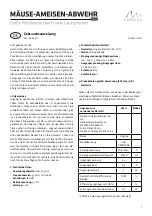
3 of 108
en
SUMMIT
®
SI
Occipito-Cervico-Thoracic
(OCT) Spinal Fixation System
and MOUNTAINEER
®
OCT
Spinal System
IMPORTANT NOTE TO
OPERATING SURGEON
The SUMMIT
®
SI Occipito-Cervico-Thoracic (OCT) System
and MOUNTAINEER
®
OCT Spinal System implants, like
other internal fixation devices, have a finite useful life. The
patient’s activity level has a significant impact on this useful
life. Your patient must be informed that any activity increases
the risk of loosening, bending, or breaking the implant com-
ponents. It is essential to instruct patients about restrictions
on their activities in the postoperative period and to examine
the patient postoperatively to evaluate the development of
the fusion mass and the status of the implant components.
Even if solid bone fusion occurs, implant components
may nevertheless bend, break, or loosen. Therefore, the
patient must be made aware that implant components may
bend, break, or loosen even though restrictions in activity
are followed.
Because of the limitations imposed by anatomic consider-
ations and modern surgical materials, metallic implants cannot
be made to last indefinitely. Their purpose is to provide
temporary internal support while the fusion mass is consoli-
dating. These types of implants are more likely to fail if no
bone graft is used or if a pseudo arthrosis develops.
The surgeon may determine to remove these implants after
bone fusion occurs. The possibility of a second surgical
procedure must be discussed with the patient, and the risks
associated with a second surgical procedure must also be
discussed. If the implants do break, the decision to remove
them must be made by the physician who must consider
the condition of the patient and the risks associated with the
presence of the broken implant.
DESCRIPTION
The SUMMIT SI OCT Spinal System and MOUNTAINEER OCT
Spinal System are designed to stabilize and promote fusion.
The SUMMIT SI OCT Spinal System and MOUNTAINEER OCT
Spinal System consist of plates, nuts, bone screws, rods,
transverse rod connectors, lateral offset connectors, head-to-
head connectors, cable connectors, dual wedding band and
axial connectors, set screws, minipolyaxial screws, monoaxial
screws, hooks and SONGER
®
Cables. The components are
manufactured from Titanium Alloy (Ti-6Al-4V).
MOUNTAINEER Longitudinal rods are also available in
cobalt-chromium-molybdenum alloy conforming to ASTM
F-1537. Cobalt-chromium-molybdenum alloy rods are
intended for use with titanium components only.
For occipitocervicothoracic fusion, either the transition rod
is bent and cut to the appropriate length or a pre-bent rod
is used. The occipital plate is fixed to the occiput with bone
screws and the transition rod is attached to the plate by a
locking mechanism. This locking mechanism consists of
a bolt and a washer which are free to rotate and translate
along a slot in the occipital plates. The rod loads from the
top and is fixed and locked into place. Sub-axially, cable
connectors are fixed to the transition rod and attached to
the spine via sublaminar cabling looped through the cable
connectors. Hooks are also available for fixation to the
spine. The end of the construct is stabilized with polyaxial
screws to the upper thoracic spine, as required.
The SUMMIT SI OCT System and MOUNTAINEER
OCT Spinal System can also be linked to the ISOLA
®
,
MONARCH
®
, MOSS
®
MIAMI, VIPER
®
and EXPEDIUM
®
systems using the dual wedding band (side-by-side) and
axial connectors (end-to-end), and via dual diameter rods.
The occipital plate assemblies are offered in a variety of
sizes and configurations. These plates are designed to allow
for contouring intraoperatively by the surgeon as required.
The unicortical occipital bone screws are 4.5mm or 5.25mm
in diameter and are available in multiple lengths.
The longitudinal members of the SUMMIT SI OCT System
and MOUNTAINEER OCT Spinal System: spinal rods, tran-
sition rods, and dual diameter rods, are available in various
diameters and lengths. Transverse connector and assem-
blies are available to link the two longitudinal members to
provide additional stability in axial rotation. Minipolyaxial
and monoaxial screws are used to secure the construct to
the upper thoracic spine. These screws are available in vari-
ous diameters and lengths. Dual wedding band connectors
(side-by-side) and axial rod connectors (end-to end) are
available in a variety of sizes.
For posterior cervical spine internal fixation, hooks or cable
connectors can be attached to the longitudinal member with
set screws. The construct is positioned over the laminae of
the spinal segments to be instrumented. SONGER
®
Cables
are looped around the laminae and passed through the
cable connectors and tensioned appropriately.
CLEANING AND STERILIZATION
Implants of the SUMMIT SI OCT Spinal System and
MOUNTAINEER OCT Spinal System are supplied clean and
not sterile. They have been validated according to AAMI TIR
Содержание DePuy Synthes MOUNTAINEER
Страница 54: ...54 of 108 1 H 2 T 3 H 4 E A T B C O...
Страница 55: ...55 of 108 D E E K 1 T 2 O 3 K 4 1 2 3 4 5 6 7 5 1 2 3...




































